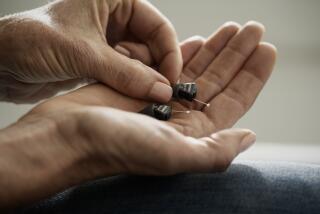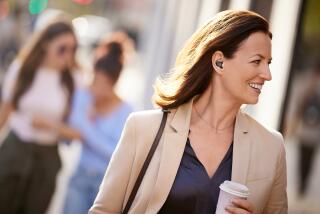Listen to This, Boomers
- Share via
Production manager Paul Moen goes through two cell phone batteries a day while working on location in Pasadena on “The Other Sister,” a Disney movie scheduled for release in the fall.
Then there are the in-person conversations with everyone from his assistants to the on-site cook. It adds up to a lot of talking--and listening.
The latter task is complicated by the fact that Moen has hearing loss in his left ear, brought on by a close-range shotgun blast during a pheasant-hunting trip five years ago. His high-decibel childhood probably didn’t help matters, he concedes. Growing up on a Fresno ranch, he rode in private planes with his pilot dad, drove tractors, played drums in a band and worked at a gravel plant.
On the hunting trip, he had put in earplugs but removed them shortly before the mishap. The next morning, his right ear buried in the pillow, “I couldn’t hear the beep, beep of the alarm,” he recalls. Soon after, “I found myself not able to follow conversations in a restaurant.”
For several years, Moen, 46, coped the best he could. Then, last summer, he got a hearing aid. He doesn’t yet wear it all the time but says he is going to try. “I do understand conversations better.”
*
The incidence of hearing loss among members of the baby boomer generation, people Moen’s age, is increasing.
Last year, California researchers reported that hearing loss among subjects 50 and older in the Alameda County Study, a long-term investigation of health and mortality, has nearly
doubled in the past 30 years and is occurring at younger ages.
In the study, published last year in the American Journal of Public Health, researchers Margaret Wallhagen, an associate professor of nursing at UC San Francisco, and her colleagues assessed changes in the prevalence of hearing impairment in more than 5,000 subjects 50 and older from 1965 to 1994.
In 1965, 9.2% of respondents reported they experienced difficulty hearing. By 1994, 17% said they had hearing loss.
The same large increases in hearing loss among boomers are reported in the national health interview surveys, conducted regularly by the National Center for Health Statistics, says William Strawbridge, a senior research scientist at the California Department of Health Services’ Human Population Laboratory in Berkeley and a co-author of the Alameda study.
In the 1963-65 national survey, 70 of every 1,000 people ages 45 to 64, or 7%, reported hearing loss. By 1993, 143 of every 1,000 people in that age bracket, or more than 14%, reported hearing loss.
*
“It used to be people would come in for hearing aids at age 60,” says Nancy Nadler, spokeswoman for the League for the Hard of Hearing, a New York-based private nonprofit organization. Now, some are fitted in their 40s or 50s.
What’s to blame? While noise on the job is decreasing, thanks to stricter regulations, environmental and leisure-time noise is increasing, experts say.
“We’re replacing one source of noise with another,” says Dr. John W. House, president of the House Ear Institute, a research and education facility, and a physician at the House Ear Clinic, both in Los Angeles.
“Baby boomers have been exposed to loud noise, particularly from loud music, discos, rock-type music, growing up with it from a fairly young age,” House says.
While permanent hearing loss in infants and young children is most often due to congenital causes or a complication of meningitis, hearing loss in those 45 and older is often the result of long-term exposure to excessive noise levels, House says.
Prolonged exposure to noise levels above 90 decibels can cause gradual hearing loss, according to the National Institutes of Health’s National Institute on Deafness and Other Communication Disorders. City traffic noise reaches about 80 decibels; a chain saw is about 110. Noise from rock concerts, motorcycles and small-arms fire can reach about 140 decibels. Over time, all that noise can damage the sensitive hair cells of the inner ear and the auditory nerve.
A single exposure to very loud noise can also cause hearing damage.
“About 10% of the population is sensitive to loud noises, while another 10% is resistant,” House says. “The trouble is, there is no way to predict.”
“I do think the environment is getting noisier,” researcher Wallhagen says, but she suspects other causes as well for early hearing loss. Certain drugs, such as some diuretics and antibiotics, may play a role in hearing loss.
Whatever the causes, hearing-impaired boomers may achieve something many of their parents are still struggling with: banishing the stigma. Moen says he doesn’t feel self-conscious when wearing a hearing aid. Nor, apparently, does President Clinton, who was fitted last year with two hearing aids. Sales of hearing aids rose 10.1% during the last quarter of 1997 compared with the same quarter of 1996.
“The people who stay away from hearing aids these days are older,” House says. Patients in their 80s, he says, are more likely to say, “I’m not old enough for that,” than are those in their 40s or 50s.
Some say boomers are willing to adapt to hearing aids because of determination to live life to the fullest, whatever it takes. But it can’t hurt that many boomers are also technology buffs, that hearing devices have gotten more sophisticated and that they’ve also become much smaller. In the future, a device that is totally implantable might be available.
*
When a patient with suspected hearing loss arrives for an evaluation, House says, there should be questions about exposure to noise.
Next comes a hearing test, conducted as the patient sits with earphones in a soundproof booth. An evaluation takes at least half an hour, says Diana Combs, an audiologist at House Ear Clinic. A complete test evaluates how loud a sound must be before the patient hears it, how soft a sound the patient can hear and how well a patient can hear different frequencies of sound and understand speech.
When the results are in, the patient is told the degree of hearing loss, whether the loss is conductive (a problem in the middle or outer ear) or sensorineural (due to an inner ear problem, such as nerve damage), which frequencies are involved and whether the loss is mild, moderate, severe or profound.
Recommendation of a hearing aid may depend on the hearing demands that the person faces.
“A teacher of small children with even a mild loss in high frequencies might benefit,” Combs says. New wearers of hearing aids should expect an adaptation period of three to 12 weeks, she says.
Rarely recommended these days is the cumbersome behind-the-ear model. Newer options are sleeker, classified as in-the-ear, canal aids and completely-in-the-canal, says Sigfrid Soli, director of hearing aid research for House Ear Institute. These all work by amplifying sound. Newer models rely on a digital chip, promising a cleaner sound. These digital devices can be more easily programmed to environmental needs. If you work in an office with a noisy photocopy machine, for instance, its noise can be muffled somewhat with specific programming.
A single hearing aid can run $800 to $3,000 or more, with digitals on the upper end of that scale. Generally, the smaller a hearing aid, the more it costs.
Fueling the boom in hearing aid development, says Soli, are advances in technology coupled with boomers’ general willingness to try the devices. Still, they’re not perfect.
Feedback, a high-pitched whistling sound, is a frequent annoyance for hearing-aid users. Soli and his colleagues are working on a feedback canceler that could be built in.
“Eventually,” he says, “the hope is this would be built in to all kinds of hearing aids.”
Being tested too are hearing devices designed to mimic the natural response of the ear more closely. One such device, under development by Symphonix Devices in San Jose, the “vibrant soundbridge,” includes a 1-inch battery-operated processor, worn behind the ear, and a transducer, tinier than a grain of rice, that is surgically implanted to the anvil bone in the middle ear. The transducer helps vibrate the middle ear bones, and these vibrations are transmitted to the inner ear so that the wearer hears sounds much like someone without a hearing impairment.
The soundbridge device could be on the market by 2000, says Geoffrey R. Ball, Symphonix’s vice president. Cost is expected to be slightly more than a new digital hearing aid. Eventually, the goal is to make the device totally implantable, says Soli, who is involved in research on a similar device.
(BEGIN TEXT OF INFOBOX / INFOGRAPHIC)
Bombarded by Noise
Everywhere we go we are surrounded by noise, from traffic to music to airplanes. Experts warn that prolonged exposure to sound above about 90 decibels can cause gradual hearing loss.
*
Legend
Gradual hearing loss with prolonged exposure.
One minute of regular exposure may risk permanent loss.
*
No more than 15 minutes of unprotected exposure is recommended.
*
Whisper: 30 db at 15 ft.
Light traffic: 55 db at 50 ft.
Jack-hammer: 85 db at 50 ft.
Loud shout: 100 db at 50 ft.
Rock concert: 117 db
Household noise (urban): 50 db
Normal conversation: 60 db at 1 ft.
Heavy traffic: 90 db at 50 ft.
Jet taking off: 105 db at 2,000 ft.
Airplane taking off: 140+ db at 200 ft.
*
Decibels. Note: A 10 db increase means that the sound is actually ten times louder.
*
Loss of Hearing
All hearing loss is either conductive--faulty transportation of sound from the outer to the inner ear--or sensorineural--when the sound that reaches the inner ear is not transmitted to the brain due to nerve or cochlear damage.
As we age, our hearing deteriorates, but there are many other things that can compound loss. Extremely loud noise can instantly deafen. Or loss may be gradual due to prolonged exposure to loud noise, fluid buildup or infection of this very delicate instrument.
*
Conductive deafness
Perforated eardrum
Earwax buildup in the outer ear.
*
Sensorineural deafness
Meniere’s disease: fluid buildup in the canals.
Acoustic neuroma: benign tumor on the auditory nerve.
Otosclerosis: Excessive growth immobilizes the stapes bone.
Middle ear effusion: fluid buildup.
Barotraumna: pain or damage due to difference in air pressure--often due to air travel.
*
The Sound of Things to Come
Traditional hearing aids can be problematic for their users. Some have poor quality sound reproduction. Some have unwanted feedback, and some can be uncomfortable to wear. One answer to this is the vibrant soundbridge, a device that is surgically implanted into the ear and could change the way we think of a hearing aid.
*
How It Works
1. Sound is received by the audio processor, a microphone that is held in place behind the ear by a magnet and is hidden under the hair.
2-3. A receiver, implanted in the skull, captures the signal, converts it into tiny electrical impulses and transmits it along a fine wire called the conductor link.
4. The impulse reaches the floating mass transducer, a tiny device--smaller than a grain of rice--that is attached to the bones in the ear. It vibrates the bones in such a way that the sound is heard clearly by the brain.
Audio processor
Internal implanted receiver
Conductor link
Middle ear bones
Nerve
Ear canal
Eardrum
Floating mass transducer
Cochlea
Semicircular canals
Sources: Symphonix Devices Inc.; the AMA Encyclopedia of Medicine; the MacMillan Visual Desk Reference.





